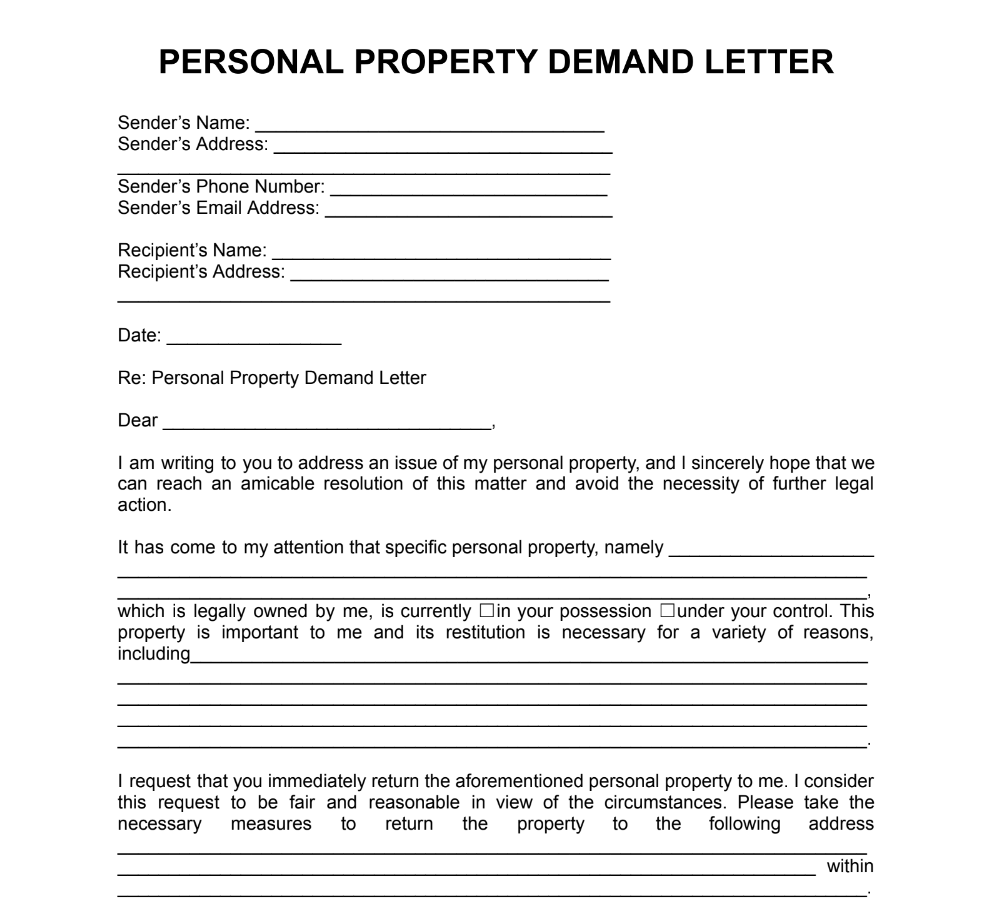When to Use a Personal Property Demand Letter
It is advisable to consider writing a letter to retrieve personal property in the following prime scenarios:
- After moving out, you discover that you forgot some belongings at the old rental, and the landlord is failing to return them.
- You lent someone an item, and they’re delaying or refusing its return.
- You placed items in storage with a company or individual, and they’re withholding your property.
Remember, a personal property demand letter is not limited to these situations. It can be used whenever you need to assert your claim over personal property held by another party.
Terms and Parties of Personal Property Demand Letter
A typical sample demand letter for return of personal property involves two crucial parties:
- Sender: This is the person or organization claiming rightful ownership of a specific personal property and advocating for its return. Responsibilities include generating and dispatching the personal property demand letter, identifying the item(s) in question, and detailing the circumstances underlying the claim.
- Recipient: This refers to the individual or entity in possession of the disputed property. The demand letter is directed to them, and depending on the context, they are expected to engage in a response and negotiate a suitable arrangement for the return of the property.
Clarity and understanding of this legal communication can be improved by using a free-to-use personal property demand letter template. The letter includes vital terms:
- Personal property: This pertains to tangible items that a person or company owns, excluding immovable property such as real estate. Items can range from electronics and vehicles to furniture and personal belongings.
- Demand letter: A formal, written correspondence that sets forth a claim or request, primarily concerning the recovery of personal property or debt. This letter often serves as a preliminary step for dispute resolution prior to formal legal proceedings.
- Resolution: The way in which the conflict over personal property is resolved. This often takes place through negotiation, straightforward return of the property, or possibly, a payment that aligns with the property’s value.
How to Create a Personal Property Demand Letter
The crafting of the demand letter for personal property should be treated with a high level of professionalism. Here’s a step-by-step guide:
- Identify the parties — Include full, current, legal names and addresses of both claimant (sender) and holder (recipient).
- Describe the property — Give a detailed description of your property. If you have photos, unique identifiers, or serial numbers, include them to make your claim more compelling.
- Detail circumstances of holding — Describe the conditions under which the holder came to possess the property. Be concise, precise, and honest.
- Demand return — Clearly state that you demand the immediate return of your property. Share your preferred method of retrieval and set a deadline.
- State potential legal action — Inform the holder that failing to comply with the demand could result in legal action. Consult an attorney for advice on specific phrasing.
- Contact details — Provide your contact information for follow-ups.
- Sign and date — Signing the letter confirms your intent, so ensure the claimant’s signature is included alongside the date.
- Send the letter — It’s advised to use a method that provides proof of receipt, such as registered mail or courier service.
While professional help can be used to draft these letters, this guide provides a basic blueprint for creating a proficient personal property demand letter. Additionally, take advantage of this free demand letter for return of personal property template to simplify your process.
This customizable template is designed to capture all the necessary details, easing the task of drafting your letter and ensuring that your demand for the return of personal property is communicated effectively and professionally.
 Preview
Preview

 Preview
Preview
